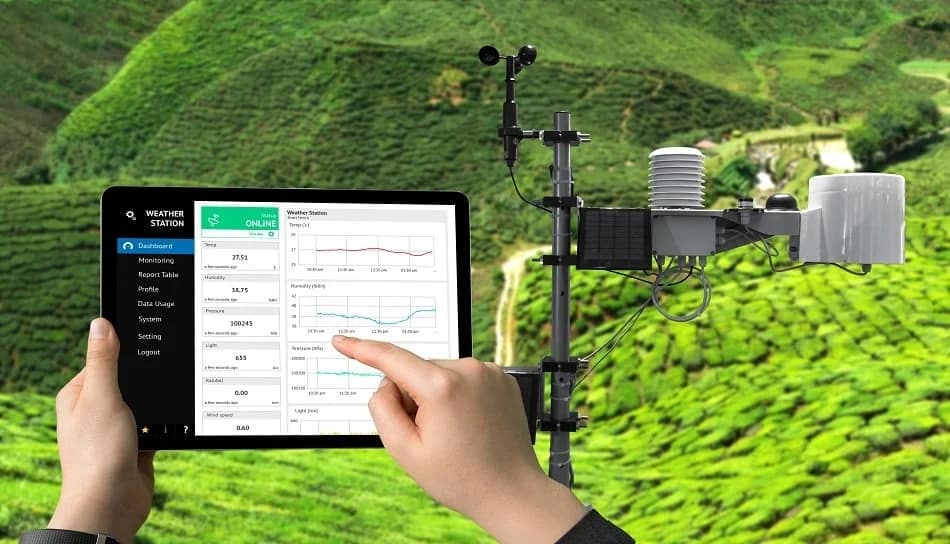What is environmental monitoring? If you’ve ever pondered this question, you’re not alone. In an age characterized by urgent environmental issues, the demand for thorough, data-driven methods to protect our planet has never been more crucial.
Environmental monitoring, situated at the crossroads of science and technology, serves as a critical tool in comprehending and addressing the effects of human actions on our environment. This article delves into the essence of environmental monitoring, its significance, and its impact on our daily existence.
You may also like: What is GPS asset tracking?

What is environmental monitoring?
Environmental monitoring, often referred to as “environmental surveillance” or “environmental assessment,” is a systematic process of collecting, analyzing, and interpreting data related to the environment.
This field encompasses various scientific disciplines – including biology, chemistry, physics, and technology, and is essential for assessing the state of the natural world, identifying changes, and making informed decisions about the environment. Environmental monitoring is vital for a multitude of reasons, including:
- Biodiversity Conservation: By tracking the health of ecosystems and species, environmental monitoring helps in conserving biodiversity. It provides early warnings of species decline or habitat destruction, enabling conservation efforts.
- Climate Change Mitigation: Monitoring environmental parameters such as temperature, greenhouse gas concentrations, and sea levels is essential for understanding and addressing the impacts of climate change.
- Water Quality: Regular monitoring of water bodies, like rivers and lakes, ensures safe and clean drinking water, reducing the risk of waterborne diseases.
- Air Quality: Monitoring air pollutants helps reduce the risk of respiratory diseases and guides policies to combat air pollution.
- Resource Management: It aids in the sustainable management of natural resources, including fisheries, forests, and agricultural land.
- Early Warning Systems: Environmental monitoring systems enable early detection of natural disasters such as floods, hurricanes, and wildfires, saving lives and property.
- Health Protection: Monitoring environmental factors like toxic chemicals and radiation helps protect human health by preventing exposure to harmful substances.
How does environmental monitoring work?
Now that you’ve gained an understanding of what is environmental monitoring and its various applications, it’s crucial to delve deeper into the way it works. Environmental monitoring is a complex system composed of several interrelated elements that work harmoniously to collect data effectively.
In the field, a wide array of devices is deployed to measure a range of environmental parameters, including temperature, humidity, air quality, water quality, and more. These devices encompass a spectrum, from simple handheld tools to sophisticated remote sensors.
The data collected with those devices is then transmitted to monitoring stations or databases for analysis. In recent years, the advent of the Internet of Things (IoT) has revolutionized data collection by providing real-time connectivity and remote monitoring capabilities.
So, after the data is collected, advanced software and algorithms come into play, processing the raw information and transforming it into actionable insights. The data generated through environmental monitoring serves as the foundation for creating reports that disseminate critical information to policymakers, researchers, and the general public. These reports play an indispensable role in shaping decision-making processes.

Also, it is important to notice that environmental monitoring often operates within a framework of government regulations and standards. These regulations are in place to ensure data quality and accountability, promoting the responsible management of environmental data.
Environmental Monitoring Techniques encompass a wide spectrum of methods, each designed to accurately capture essential data. Some of the most commonly used techniques include:
- Remote Sensing;
- Ground-Based Monitoring;
- Biological Monitoring;
- Air Quality Monitoring;
- Water Quality Monitoring;
- Meteorological Monitoring.
Once this data is gathered, it embarks on a digital journey to monitoring stations or databases through the magic of the Internet of Things (IoT). This real-time connectivity and remote monitoring capabilities have revolutionized the way we collect and transmit data, making the process more efficient and responsive.
But the true marvel lies in the digital realm, where advanced software and algorithms spring to life; they meticulously process the raw data, unveiling hidden patterns and insights that may elude the human eye. These actionable insights serve as the building blocks for comprehensive reports that reach policymakers, researchers, and the general public, empowering them to make informed decisions that have a profound impact on our environment and society.
However, it’s essential to remember that environmental monitoring doesn’t operate in isolation. It operates within a framework of government regulations and standards, ensuring data quality, transparency, and accountability.
Applications of environmental monitoring
At this point, we hope you can understand what is environmental monitoring. Environmental monitoring has diverse applications that impact various aspects of our lives. Here are some examples:
Climate change research
What is environmental monitoring? Environmental monitoring is of paramount importance in our efforts to assess and comprehend the far-reaching implications of climate change. Through systematic tracking of various parameters, such as temperature patterns, carbon emissions, and sea level rise, we gain valuable insights into the profound shifts occurring in our environment.
These data not only provide critical evidence of climate change but also serve as the foundation for informed decision-making and policy development. By continuously monitoring these factors, we can better predict and mitigate the impacts of climate change, ultimately contributing to the preservation of our planet for future generations.
Air quality management
Monitoring air quality in urban areas is a crucial tool in identifying the sources of pollution and guiding policies aimed at achieving cleaner and healthier urban environments. The data obtained from these monitoring efforts offer valuable insights into the types and levels of pollutants present, allowing authorities to take targeted action to reduce emissions.

This, in turn, leads to significant improvements in public health, as cleaner air directly translates to lower instances of respiratory diseases, cardiovascular issues, and other health concerns associated with poor air quality. By continuously monitoring and acting upon air quality data, cities can foster a better quality of life for their residents and set the stage for sustainable and vibrant urban communities.
Natural disaster management
Environmental monitoring systems serve as a crucial lifeline in our efforts to safeguard communities and respond to the growing threats of natural disasters, including hurricanes, floods, and wildfires. By constantly tracking various environmental parameters, such as atmospheric pressure, rainfall, and temperature, these systems can provide early warnings of impending disasters.
This invaluable lead time enables authorities to swiftly initiate evacuation plans, mobilize resources, and implement mitigation measures, ultimately reducing the potential damage and, most importantly, saving lives. In a world where climate change is increasing the frequency and intensity of such events, these monitoring systems are pivotal in bolstering resilience and preparedness in the face of nature’s fury.
Agriculture
Farmers are increasingly relying on environmental monitoring data to revolutionize their agricultural practices. By constantly monitoring factors like weather conditions, soil moisture, and pest populations, they gain valuable insights that enable them to make informed decisions and optimize crop yields. This data-driven approach not only improves productivity but also reduces resource wastage, as it allows for more precise irrigation and fertilization.
Moreover, it plays a significant role in promoting sustainable farming practices by reducing the environmental impact of agriculture. As the world grapples with food security and the need to minimize the ecological footprint of farming, environmental monitoring has become an essential tool in ensuring that agriculture remains efficient, resilient, and environmentally responsible.
Energy efficiency
Environmental monitoring in both industrial and residential settings offers a pathway to a more sustainable and energy-efficient future. By systematically tracking energy consumption, emissions, and environmental impact, individuals and industries can identify areas where improvements are possible.
This data-driven approach not only allows for the reduction of carbon emissions but also presents opportunities for significant energy savings. It empowers businesses to optimize their operations, adopt cleaner technologies, and reduce their carbon footprint – contributing to global efforts to combat climate change.
Similarly, homeowners can make informed choices about energy-efficient appliances and behaviors that lead to reduced energy consumption and lower greenhouse gas emissions. In essence, environmental monitoring helps us transform the way we use energy, promoting a greener, more environmentally responsible approach in both industrial and residential contexts.

Join Datanet IoT
Now you know much more of what is environmental monitoring: a vital discipline that empowers us to make informed decisions and take proactive measures to protect our planet.
It provides the data needed to address climate change, preserve biodiversity, safeguard human health, and ensure sustainable resource management. With advancements in technology, especially the Internet of Things, environmental monitoring has become more efficient, cost-effective, and accessible.
As we move forward in an increasingly interconnected world, we must embrace environmental monitoring as an integral part of our efforts to combat environmental challenges. The data collected and analyzed through environmental monitoring will continue to guide us in making responsible decisions for the benefit of the environment, society, and future generations.
To bolster the effectiveness of environmental monitoring, it’s crucial to advocate for the adoption of IoT for data collection and analysis. If you’re interested in implementing environmental monitoring within your company, don’t hesitate to reach out to our team at Datanet IoT Solutions!
We specialize in harnessing state-of-the-art Internet of Things technologies to create customized solutions that cater to your unique business requirements. We eagerly await your contact and the opportunity to collaborate with you, your team, and your organization!







